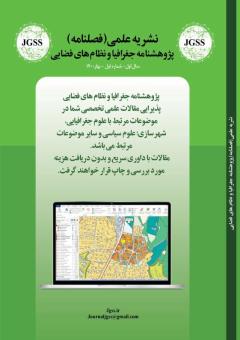تحلیل وضعیت زیست¬پذیری مجتمع¬های مسکونی انبوه(مورد پژوهی:محله بهار شهر اصفهان)
محورهای موضوعی : Urban planningفرزانه دهقانی گیشی 1 , داریوش مرادی چادگانی 2
1 - کارشناس ارشد برنامه ریزی شهری دانشگاه هنر اصفهان
2 - استادیار
کلید واژه: زیست¬پذیری, مسکن انبوه, محله بهار, شهر اصفهان,
چکیده مقاله :
افزايش جمعیت در شهرها ، منجر به انبوه سازي مسكن شده است. امروزه فرسودگی مناطق متراکم و ساختمانهای بلند مرتبه از جمله واقعیتهای شهرهای بزرگ می باشند و به همراه خود مسائل، مشکلات و نیازهای خاصی را ایجاد کرده است چنین بافتهای روز به روز با کاهش شرایط زیست پذیری روبرو می شود ، چرا که به دلیل فرسودگی کالبدی، عدم برخورداری مناسب از تاسیسات، خدمات و زیرساختهای شهری آسیب پذیر بوده و از ارزش مکانی، محیطی و اقتصادی نازلی برخوردارمی شود. محله بهار که در جنوب شهر اصفهان واقع شده ، پس از گذشت 47 سال از ساخت آن، با افت شرایط زست پذیری روبرو گردیده است و این ساختمانهای قدیمی، نمای نامطلوبی را برای منطقه 6 شهر اصفهان ایجاد کرده است. هدف اصلی این پژوهش تحلیل وضعیت زیست پذیری مؤلفه های مسکونی، مؤسسات تولیدی-خدماتی و روفاه عمومی، ،وضعیت مجراهای انطباق یافته و ساختار تصمیم گیری می -باشد که برای ارزیابی وضعیت شاخص های ذکر شده پرسشنامه ای با حجم نمونه 135 نفر از ساکنان محله بهار تدوین گردیده و با استفاده از آمارتوصیفی و استنباطی و آزمون میانگین به کمک نرم افزار SPSS تحلیل شده است. براساس نتایج حاصل از پژوهش، ساختار فضائی-فعالیتی مسکونی و ساختار تصمیم گیری مهمترین زمینه-هایی در وضعیت نامناسب، و ساختمانهای فرسوده و کم دوام، عدم جذب سرمایه گذار در زمینه مسکن ، عدم مشارکت ساکنان با یکدیگر، توان اقتصادی پایین ساکنان، عدم اعتماد ساکنان به شهرداری، دشورا بودن دریافت پروانه ساخت و ساز در محله از مهمترین مؤلفه های آن می باشد.
Increasing population in cities has led to mass housing. Today, the erosion of dense areas and high-rise buildings are among the realities of large cities and have created special problems, problems and needs. Such tissues are facing a decrease in living conditions day by day. Because of physical deterioration, lack of proper facilities, services and urban infrastructure is vulnerable and has a low spatial, environmental and economic value. Bahar neighborhood, which is located in the south of Isfahan, after 47 years of its construction, has faced a decline in livability conditions, and these old buildings have created an unfavorable view for the 6th district of Isfahan. The main purpose of this study is to analyze the viability of residential components, production-service institutions and public housing, the condition of adapted ducts and decision-making structure. To evaluate the status of the mentioned indicators, questionnaires with a sample size 135 residents of Bahar neighborhood were compiled and analyzed using descriptive and inferential statistics and mean test using SPSS software. According to the results of the study, the spatial-activity structure of housing and decision-making structure are the most important areas in poor condition, and dilapidated and low-durability buildings, lack of investment in housing, lack of participation of residents, low economic potential of residents Resident’s lack of trust in the municipality, the difficulty of obtaining a construction permit in the neighborhood is one of its most important components
ارجمندنیا، اصغر (1370)، جمعیت و مسکن، مجله محیط شناسی، دوره 16،صص 38-25.#
حیدری، محمدتقی، انبارلو، علیرضا، رحمانی، مریم، طهماسبی مقدم، حسین(1399)، پایش زیست¬پذیری اجتماعی در مناطق فرسوده شهر با رویکرد آینده پژوهی( مطالعه موردی: بافت فرسوده بخش مرکزی شهر زنجان) ، مجله جغرافیا و برنامه¬ریزی، شماره 73، صص 155-121.#
خراسانی، محمد امین، اکبریان رونیزی، سعیدرضا(1399)، ارزیابی زیست¬پذیری در نواحی روستایی پیراشهری(مطالعه موردی: بخش مرکزی شهرستان شیراز)، مجله برنامه¬ریزی منطقه¬ای شماره 40؛ صص146-133.#
سعیدنیا، احمد (1383)، نظام مراکز شهری/ فضاهای مسکونی، کتاب سبز شهرداری¬ها، جلد چهارم، انتشارات سازمان شهرداری¬ها و دهیاری¬های کشور.#
شهرداری اصفهان(1395)، www.isfahan.ir، آمارنامه شهرداری اصفهان، تاریخ دسترسی2/11/1399#
کلانتری، خلیل، آباد، حسین، پوراحمد، احمد(1385)، فنون و تجارب برنامه ریزی مرمت بافت تاریخی شهرها، انتشارات جهاد دانشگاهی.،صص31-30#
Bernos. D, Duarte. J.p (2009), An integrated system for providing mass customized housing, Automation in Construction, No,18: pp310-320.#
Heylen. K (2006), Livability in social housing: Three case-studies in Flanders, urban planning institute of the republic of Slovenia, International Conference Workshop 18 - Residential Environments and People.#
Isalou. A, Litman. T, Shahmoradi. B (2014), Testing the housing and transportation affordability index in a developing world context: A sustainability comparison of central and suburban districts in Qom, Iran. Transport Policy.#
Landry. Ch (2000), Urban Vitality: A New source of Urban Competitiveness, prince claus fund journal, ARCHIS issue Urban Vitality / Urban Heroes.#
#Lennard. H.L (1997), Principles for the Livable City In Lennard, International Making Cities Livable Conferences, pp.14-46
Mahmoudi. M, Ahmad. F, Abbasi. B (2015) Livable street: the effect of physical problem on the quality and livability of #Kuala Lumpur streets, Cities, No(43), pp:104-114.
#Miller. C, Mac Alister. J (2013), Vitality in urban space, livalble city coference, Sidny, Auostralia, pp:1-2
#Noordin. M (2013) Planning for Liveable Cities, Organized by JPBW Sabah, Vol 3, No 8, pp.1-13.
Timmer. V. Seymoar. N.k (2005), The Livable City Proceedings of The World Urban, International Centre for Sustainable cities, Vancouver, Canada. (pp.45-65).#
Van Kamp. I, Leidelmeijer. K, Marsman. G, De. H (2003), Urban environmental quality and human well-being: Towards a #conceptual framework and demarcation of concepts; a literature study, Landscape and Urban Planning, pp:5-18.
#Wheeler. S, (2001), Livable Communities: Creating Safe and Livable Neighborhoods, Towns, and Regions in California.


